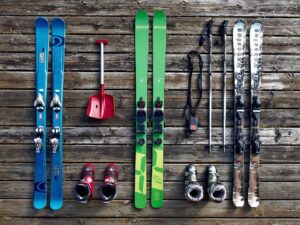Ski season is here, so it’s time to get your skis ready for some powder. Whether you’re a beginner or an expert, you’ll want to make sure your bindings are properly tightened before heading out onto the mountain.
The right fit will help keep you safe on the slopes and prevent injuries from happening during your run. We’ve put together some tips for tightening ski bindings and getting them set just right for your needs:
Put on your ski boots.
Step 2: Put on your ski boots.
- Make sure that your boots fit properly. They should be comfortable and not too tight or too loose, with a slight amount of space at the top of the boot for when you flex down onto your toes (i.e., don’t put on super thick socks). Also, make sure they’re broken in before you get out onto the mountain so they’re not giving you blisters that will ruin your ski day!
Slide your skis into the bindings
Slide your skis into the bindings and make sure the heel piece is in the upright position.
Now, grab your poles. If you’re right-handed, hold one pole in your left hand with the basket facing outwards.
Place it against your right ski so that they’re parallel to each other, then push down on top of it with some force so that it snaps into place. Repeat this step for your left ski.
Screwdriver to tighten the front of the toe binding.
Now that you are standing on the slope, you can use a screwdriver to tighten the front of your toe binding.
To do this, place one hand behind your ski and grab hold of your toe with the other. Take care not to move while tightening so that you don’t accidentally break or bend any parts of the binding (which could make it unsafe).
Once everything is in place, apply firm pressure until you hear a “click.” This indicates that the tightening process has been completed correctly.
To check whether or not you’ve tightened properly, look at how far back your heel is when compared to where it should be according to instructions given by manufacturers/individual bindings (the further forward they’re out).
If all seems well here then congratulations! You have successfully tightened your skis
Tighten the rear of the binding using a screwdriver
Now that you’ve loosened the front of your ski binding, it’s time to tighten up the back. To do this, use a screwdriver and insert it into the hole at the rear of your ski boot.
Then turn it clockwise until you feel resistance from pulling on both ends of a cable inside your boot (don’t worry about getting too excited or turning too fast).
If you can’t get enough leverage on either side of this cable by hand, consider using a wrench instead of a screwdriver—just make sure not to over-tighten or else you could damage your bindings and/or boots!
Finally: never use a hammer when tightening any part of your ski gear—it can damage nearby parts and lead to injury if used incorrectly by inexperienced users.
Step on top of your ski
Once you have your ski boots on, step on top of your ski and make sure that your feet can move forward and back slightly within the binding.
If they are too tight, you will not be able to move them at all. If they are too loose, your feet will move too freely.
Bend down and lift up your heels freely
Bend down and see whether or not you can lift up your heels freely and without resistance. If you can’t, the bindings are too tight. If you can lift up your heels without resistance, the bindings are too loose.
In a friendly tone: “You’ll have to tighten them.”
Bindings aren’t too tight or too loose
To make sure your bindings are tightened properly, you should be able to feel resistance when you move your feet forward and back. If the bindings are too loose, your ski could slide forward and get stuck between your foot and the binding.
This can be dangerous and cause injury.
If they’re too tight, however, there may not be enough room for your boot to flex naturally as it presses against the ski edge during turns—and this can also lead to injuries like sprained ankles or torn ligaments in addition to difficulty making turns!
Conclusion
If you’re looking to get more comfortable on the slopes this winter, remember that your bindings should be tight enough so that they don’t move around and are still comfortable to wear.
If you are experiencing pain or discomfort, it may be time for new ski boots! If you want to learn more about how to properly fit yourself into ski boots then check out our blog post here: https://www.nordicheathen.com/how-to-fit-yourself-into-ski-boots/

